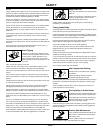
Safety - 8
SAFETY
• Keep all nuts and bolts tight, especially blade attachment bolts, to be
sure the equipment is in safe working condition.
• Never tamper with safety devices. Check their proper operation regularly.
• Keep machine free of grass, leaves or other debris build-up. Clean up oil
or fuel spillage and remove any fuel-soaked debris. Allow the machine to
cool before storing.
• If you strike a foreign object, stop and inspect the machine. Repair, if
necessary, before restarting.
• Never make any adjustments or repairs with the engine running. Wait for
all movement to stop on machine before adjusting, cleaning or repairing.
• Check grasscatcher components and the discharge guard frequently and
replace with manufacturer’s recommended parts, when necessary.
Grasscatcher components are subject to wear, damage, and deterioration
which could expose moving parts or allow objects to be thrown.
• Mower blades are sharp. Wrap the blade or wear gloves, and use extra
care when servicing them. Only replace blades. Never straighten or weld
them.
• Check brake operation frequently. Adjust and service as required.
• Maintain or replace safety and instruction labels, as necessary.
• On multi-bladed machines, take care as rotating one blade can cause
other blades to rotate.
• Keep hands, feet, clothing, jewelry, and long hair away from any moving
parts, to prevent them from getting caught.
• Lower any attachments to the ground before cleaning or servicing
machine. Disengage all power and stop the engine. Lock park brake and
remove the key. Let machine cool.
• Securely support any machine elements that must be raised for service
work. Use jack stands or lock service latches to support components
when needed.
• Disconnect battery or remove spark plug wire (for gasoline engines)
before making any repairs. Disconnect negative terminal first and positive
last. Install positive terminal first and negative last.
• Before servicing machine or attachment, carefully release pressure from
any components with stored energy, such as hydraulic components or
springs.
• Keep all parts in good condition and properly installed. Fix damage
immediately. Replace worn or broken parts.
• Charge batteries in an open, well-ventilated area, away from sparks.
Unplug battery charger before connecting or disconnecting from the
battery. Wear protective clothing and use insulated tools.
• Do not strike the flywheel with a hammer or hard object because the
flywheel may later shatter during operation.
• If equipped with hydraulic lift - release hydraulic pressure by lowering
attachment or cutting units to the ground or to a mechanical stop and
move hydraulic control levers back and forth.
Avoid High Pressure Fluids
• Hydraulic hoses and lines can fail due to
physical damage, kinks, age, and exposure.
Check hoses and lines regularly. Replace
damaged hoses and lines.
• Hydraulic fluid connections can loosen due to physical damage and
vibration. Check connections regularly. Tighten loose connections.
• Escaping fluid under pressure can penetrate the skin causing serious
injury. Avoid the hazard by relieving pressure before disconnecting
hydraulic or other lines. Tighten all connections before applying pressure.
• Search for leaks with a piece of cardboard. Protect hands and body from
high pressure fluids.
• If an accident occurs, see a doctor immediately. Any fluid injected into
the skin must be surgically removed within a few hours or gangrene may
result. Doctors unfamiliar with this type of injury should reference a
knowledgeable medical source. Such information is available from Deere
& Company Medical Department in Moline, Illinois, U.S.A. Information may
be obtained in the United States and Canada only by calling 1-800-822-
8262.
Prevent Fires
• Machine fires and structure fires can occur if a
machine is stored before allowing it to cool, if
debris is not removed from critical areas of the
machine, or if machine is stored near
combustible materials.
• Remove grass and debris completely from
engine compartment and muffler area, and from
on top of the mower deck, before and after operating machine, especially
after mowing or mulching in dry conditions.
• Empty any grasscatcher bags or containers completely before storing.
• Always shut off fuel when storing or transporting machine, if the machine
has a fuel shutoff.
• Do not store machine near an open flame or source of ignition, such as a
water heater or furnace.
• Check fuel lines, tank, cap, and fittings frequently for cracks or leaks.
Replace if necessary.
Handling Fuel Safely
To avoid personal injury or property
damage, use extreme care in handling fuel.
Fuel is extremely flammable and fuel
vapors are explosive:
• Extinguish all cigarettes, cigars, pipes, and
other sources of ignition.
• Use only an approved fuel container. Use
only non-metal, portable fuel containers
approved by the Underwriter’s Laboratory
(U.L.) or the American Society for Testing &
Materials (ASTM). If using a funnel, make sure
it is plastic and has no screen or filter.
• Never remove the fuel tank cap or add fuel with the engine running. Allow
engine to cool before refueling.
• Never add fuel to or drain fuel from the machine indoors. Move machine
outdoors and provide adequate ventilation.
• Clean up spilled fuel immediately. If fuel is spilled on clothing, change
clothing immediately. If fuel is spilled near machine, do not attempt to start
the engine but move the machine away from the area of spillage. Avoid
creating any source of ignition until fuel vapors have dissipated.
• Never store the machine or fuel container where there is an open flame,
spark, or pilot light such as on a water heater or other appliance.
• Prevent fire and explosion caused by static electric discharge. Static
electric discharge can ignite fuel vapors in an ungrounded fuel container.
• Never fill containers inside a vehicle or on a truck or trailer bed with a
plastic liner. Always place containers on the ground away from your
vehicle before fueling.
• Remove fuel-powered equipment from the truck or trailer and refuel it on
the ground. If this is not possible, then refuel such equipment with a


















